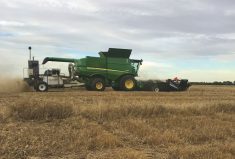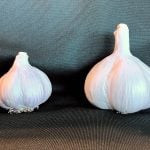[Question:] I had a weed called “chess” in my winter wheat crop at harvest. How did it get here? Is it a problem? And how do I get rid of it?
[Answer:] How did it get here? Chess (scientifically known as Bromus secalinus) is also sometimes referred to as “cheat” or “rye brome.” It is a grassy weed that infests cereals crops, and because its seed matures and is of similar size to wheat, it can become a contaminant of grain that is intended for seed. This grassy weed originates from Europe and is believed to have spread into North America through contaminated grain shipments1. Acccording to a 1980 publication, in Ontario prior to the 21st century, “Bromus secalinus was considered a serious weed in the wheat growing areas of the southwestern counties but is no longer regarded as a serious weed”2. This sentence apparently reflected the status of the weed as of the late 1970s.

Does it have an impact on winter wheat? Field studies in Oklahoma have shown 28 to 48 per cent yield loss when winter wheat was competing with a 25 plants/m2 average density of chess3.
Management options
In 2017, Simplicity herbicide was registered for use in Eastern Canada. In Western Canada, Simplicity herbicide has been used for several years to control related species such as Japanese and Downey brome. Although chess is not listed on the product label, control with Simplicity was evaluated in Kansas State. Table 1 (below) summarizes control when Simplicity was applied in the fall compared to the spring. Simplicity provided over 80 per cent control of chess regardless of application timing, but fall applications improved control by an average of eight per cent because the weed is smaller and more susceptible to the herbicide at the fall timing.

Have a question you want answered? Hashtag #PestPatrol on Twitter to @cowbrough or email Mike at [email protected].
Citations:
- Bromus secalinus (rye brome). “CABI Invasive Species Compendium.”
Assessed July 24, 2017 at: www.cabi.org/isc/datasheet/10034. - Dore and MacNeil. 1980. Grasses of Ontario Monograph 26, Agriculture. Canada, Ottawa, Ontario, Canada.
- Medlin, C.R., Peeper, T.F, Kelley, J.C., Stone, A.E. and M.A. Barnes. 2005. “Cheat Control in Oklahoma Winter Wheat.” Oklahoma Cooperative Extension Factsheet F-2774.
- Geier, P.W., Stahlman, P.W., Peterson, D.E. and M.M. Claassen. 2011. “Pyroxsulam compared with competitive standards for efficacy in winter wheat.” Weed Technology. 23:316-321.
Read Also

Agronomists share tips for evaluating new crop products and tech: Pt. 3
With new products, new production practices and new technology converging on the agriculture industry at a frenetic pace in recent…















